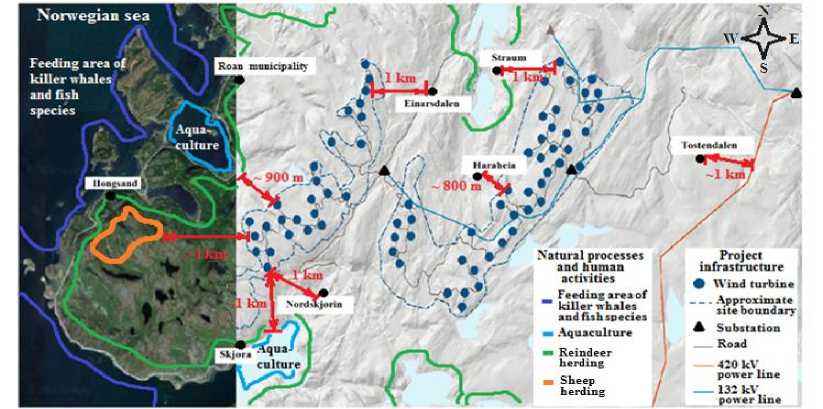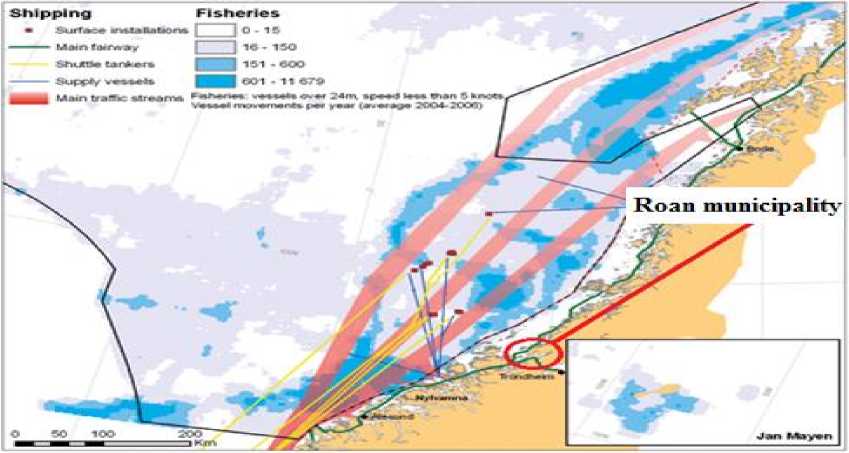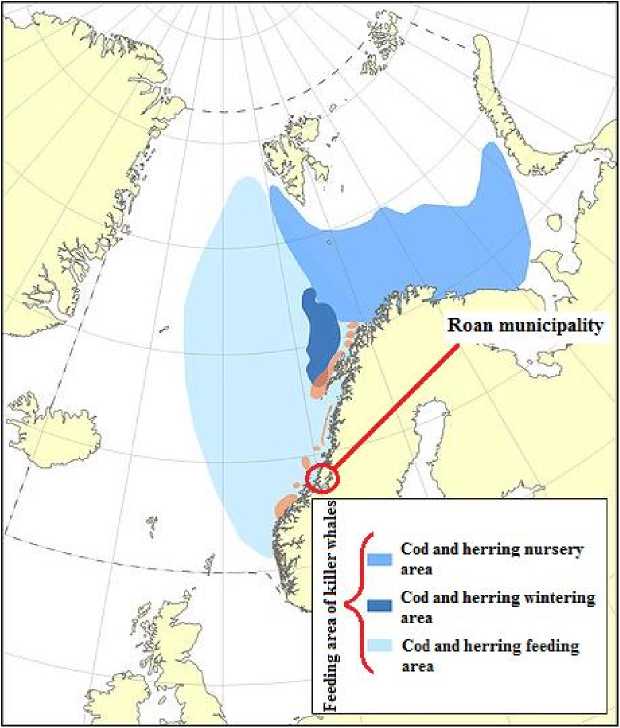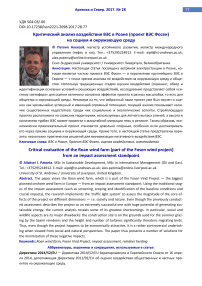Критический анализ воздействия ВЭС в Роане (проект ВЭС Фосен) на социум и окружающую среду
Автор: Патоня Алексей
Журнал: Арктика и Север @arcticandnorth
Рубрика: Экономика, политика, социум и культура
Статья в выпуске: 28, 2017 года.
Бесплатный доступ
Настоящая статья посвящена ветряной электростанции в Роане, которая является частью проекта ВЭС Фосен - в перспективе крупнейшего ВЭС в Европе - с точки зрения анализа её воздействия на окружающую среду и общество. Используя традиционные стадии оценки воздействия (скрининг, обзор и идентификация основных условий и решающих воздействий), исследование представляет собой «систему светофора» для оценки величины основных эффектов проекта в разных масштабах, т.е. для общества и окружающей среды. Несмотря на то, что избранный нами проект уже был изучен и оценен как чрезвычайно успешный и имеющий огромный потенциал, текущий анализ показывает наличие существенных недостатков. Среди них социальные и экологические аспекты. Стройплощадка проекта расположена на саамских территориях, используемых для летнего выпаса оленей, а высота и количество турбин ВЭС может привести к масштабной миграции птиц в регионе. Таким образом, экономически привлекательный проект становится довольно спорным, особенно если рассматривать его через призму социума и окружающей среды. Кроме того, в настоящей статье представлены варианты нескольких практических решений для минимизации негативного воздействия ВЭС.
Вэс в роане, проект вэс фосен, оценка воздействия, оленеводство
Короткий адрес: https://sciup.org/14823251
IDR: 14823251 | УДК: 504.03/.06 | DOI: 10.17238/issn2221-2698.2017.28.77
Текст научной статьи Критический анализ воздействия ВЭС в Роане (проект ВЭС Фосен) на социум и окружающую среду
В 2016 г. проект ВЭС Фосен был запущен норвежскими компаниями «Nordic Wind Power», «Statkraft» и «TrønderEnergi» . Он должен был стать самым крупным производством ветряной энергии на территории Европы. Кроме того, проект увеличил бы долю ветряной энергии в норвежском энергетическом секторе вдвое после ввода в эксплуатацию всех объектов инфраструктуры в 2020г.1 ВЭС в Роане — вторая по величине ветряная станция из шести запланированных, самая первая из всех, она будет построена к 2018г.2 «Statkraft»3 планирует разметить ВЭС в муниципалитете Роан в провинции Южный Тронделаг, Норвегия. Целью ветряного парка станет обеспечение дешевой возобновляемой энергией соседних поселений, а также национальной энергосистемы, что согласуется с пунктом 7 Целей устойчивого развития (ЦУР) ООН4.
Реализация проекта сулит немалую выгоду, т.к. позволит производить электроэнергию по самой низкой цене в Европе, с возможностью среднегодовой нагрузки до 3500 часов5. Кроме инвесторов, проект выгоден местным жителям, которые не только уменьшат свои затраты на электричество, но и улучшат экологию и инфраструктуру поселений6. Однако, как свидетельствует статистика [1, Wang S., Smith P.], большая часть крупномасштабных энергетических проектов влечёт за собой не только социально-экономические бенефиции, но и большое количество проблем.
Задачей настоящей статьи стала оценка последствий создания и функционирования ВЭС в Роане. В этой связи основополагающими становятся категории воздействия, определённые в норвежском законодательстве и применяемые экологическими организациями для анализа проектов ВЭС и их последствий. В работе проведена оценка и анализ величины последствий и выявлено, что большинство имеет положительные значения, а значит, и негативные последствия. Некоторые предложения по смягчению потенциально возможных угроз и улучшению показателей также представлены в данной статье.
История проекта, скрининг и анализ
-
1. История проекта
Располагая проект в муниципалитете Роан, инвесторы стремятся достигнуть максимальных величин загрузки турбин. Этому способствуют географические характеристики региона, а именно чрезвычайно высокое количество ветреных дней7. Участники проекта ВЭС Фосен (2016) решили установить в этом регионе 71 турбину с общей мощностью 255,6 МВт, что составляет четверть общей мощности проекта (1000 МВТ). Уникальные географические особенности местности позволят создать ветряную электростанцию, способную обеспечить электричеством 42,5 тыс. домов8.
-
2. Скрининг и анализ
В Норвегии правовые вопросы оценки воздействия на окружающую среду (EIA) для объектов береговой энергетической инфраструктуры регулируются законом о планировании и строительстве от 27 июня 2008 № 71 [2, Pettersson M., Ek K., Soderholm K., Soderholm P]. Кроме того, в рамках Европейской экономической зоны Норвегия обязана следовать положениям Директивы об оценке воздействия на окружающую среду ЕС (Директива 2014/52/EU), которая интегрирована в правовую систему страны [3, Bang G., Gullberg A.T.].
В то же время постоянное население региона составляет 1000 чел., проживающих в небольших поселениях, рассеянных по его территории9. Кроме того, там практически нет промышленности. Местное население занимается рыбной ловлей, сельским хозяйством и сезонным животноводством (оленеводство и разведение овец)10. Ни одно из этих занятий не требует большого объёма электроснабжения. Тогда получается, что основная доля произведённой энергии будет поставляться в национальную энергосистему страны, т.е. не будет способствовать индустриальному развитию региона11.

Рисунок 1. ВЭС в Роане: инфраструктура, природные процессы и деятельность человека Источники: авторское наложение данных, предоставленных Statkraft (2015), Nordic Center for Spatial Development (2015), Д. Вонгравен и А. Бистер (2014), Хансен (2015)
Даже несмотря на низкую плотность населения и специфические особенности экономической деятельности, решение инвесторов кажется продуманным. В то же время масштаб и сложность проекта будут иметь значительные краткосрочные и долгосрочные последствия (рис. 1). На рис. 1 виден масштаб территории, большая часть которой используется саамами для выпаса оленей. Часть ветряных установок будет размещена в относительной близости (800 м–1 км) от поселений, рыбоводческих хозяйств и земель, используемых для овцеводства. Рыбоводческие хозяйства в свою очередь имеют связь с открытым морем, т.е. с морской флорой и фауной. Установка ветряной электростанции, 71 турбины, 3-х подстанций, 70 км новых дорог и десятков метров высоковольтных линий электропередач (HVC), а также работы, запланированные Statkraft (2015), будут иметь значительное негативное воздействие на эти территории.
Согласно закону о планировании и строительстве,12 все проекты ВЭС с более чем одной ветряной установкой и способностью вырабатывать более чем 10 МВт энергии должны
URL:
пройти оценку воздействия на окружающую среду. Именно поэтому учёт масштаба проекта (см. История проекта), а также скрининг внедрения выявляет необходимость провести оценку последствий реализации проекта. В соответствии с законом о планировании и строительстве и Директивой 2014/52/EU, скрининг должен включать в себя следующие категории: (i) население и здоровье человека; (ii) биоразнообразие; (iii) земля, почва, вода, воздух и климат; (iv) активы, культурное наследие и ландшафт1314.
Однако повышенное внимание к экологическим аспектам в Норвегии и ЕС, а также экологическое законодательство упускают из виду ещё два элемента устойчивого развития: общество и экономику [4, Blewitt J]. Среди всех работ, рассмотренных по данной проблематике, лучшими, по мнению автора, можно считать работы Али [5] и Холде [6], важными — консультации с местными отделениями международных НКО («Гринпис Норвегия»15 и «Друзья Земли Норвегия»16). Благодаря этому к трём упомянутым категориям оценки были добавлены ещё несколько, что позволило сгруппировать отдельные виды последствий в два кластера: «Общество» и «Биоразнообразие».
Кластеры проанализированы с точки зрения величины воздействия через призму «Светофора» — цветового кода Системы оповещения и слежения НАТО17. Величина каждого предполагаемого отрицательного эффекта отмечена красным, положительного — зелёным; жёлтым обозначены эффекты, имеющие как положительное, как и отрицательное действие (таб. 1).
Таблица 1
|
Категории влияния |
Ключевые условия |
Местные эффекты |
Региональные эффекты |
Глобальные эффекты |
||||
|
Краткосрочный (строительство) |
Долгосрочный |
Краткосрочный (строительство) |
Долгосрочн ый |
Краткос рочный (стр-во.) |
Долгоср очный |
|||
|
о со н ф ко О |
ф .0 со о Q. О сС СП S ф S ф ф ГО X |
Недостаточное 19 население Одни из лучших показателей здоровья в Норвегии [7, Rehn Τ.Α., с. 209–216]. |
Шум от строительной техники может вызвать временные медицинские отклонения (например, бессонницу) [8, Kageyama T., с. 53–61] |
Турбинный шум и теневое мерцание могут негативно сказаться на здоровье [8]. |
Отсутствуют |
|||
|
1/7 к S ф ф ГО I н о н к го m |
Низкий уровень безработицы и активное олене- 20 водство Рыбохозяй ственная деятельность и разведение овец21. |
Сокращение территорий для выпаса оленей из-за строительства инфраструктуры проекта [9, Skarin A., с. 1527–1540]. |
Сокращение территорий пригодных для выпаса оленей вследствие фрагментации ландшафта и т.д. [9]. |
Отсутствуют |
Совокупные кумулятивные эффекты, проявляющиеся в изменении миграции оленей в Скандинавии [8]. |
Отсутствуют |
||
|
д н о ф Ф m |
Низкая потребность в энергии и высокие цены на электроэнер- 22 гию Мало автомобильных дорог23 Низкий автомобильный и авиа трафик, но высокий мор-ской24. |
Строительство дорог25. |
Низкие цены на энергоносители и боль- 26 ший их объём Развитие инфраструктуры и увеличение автомобильного трафика27. |
Отсутствуют |
Более дешёвые энергоно- 28 сители Развитие дорожной сети Норвегии и Скан-динавии29. |
Отсутствуют |
||
|
5 CL E* x X H к ro e |
На территории проекта нет объектов культурного наследия, но территория может быть интересна орнитологам [10, Haavik А., Dale S., с. 69– 80] Церковь Роана — самый близкорасположен-ный культурный объект, находится в 2.5 км от ветряных тур-бин31. |
Отсутствуют |
Возможное негативное воздействие на птиц, обитающих на территории проекта и поблизости [10]. |
Отсутствуют |
|||
|
Ф х m го CL Ю О О m го CL О x in |
'V -ero ro X ro m О e |
Территория не пригодна для земледелия – тонкие слой почвы (главным образом ска-лы)3334 Отсутствует лес, в основном лишайники [10] |
Сокращение почвенного слоя и лишайников из–за строительства инфраструктуры проекта [11, Reichenberg L., Johnsson F., Odenberger M.] Изменения ландшафта, вызванные строительством [11] |
Высоковольтные кабели негативно влияют на темп роста из лишайников и мха [12, Urech M., Elcher B. & Siegenthaler J., с. 327–334] Дороги фрагментируют ландшафт [8] |
Совокупные негативные условия для почвы и лишайников из–за строительства [8]. |
Кумулятивный эффект препятствует росту лишайников и вызывает фрагментацию [13, Vistnes I.I., Nellemann C., с. 215– 224] |
Отсутствуют |
|
mro О co |
Практически отсутствуют подземные воды из-за большого количества 36 скал Несколько мелких озёр с ры- 37 бой |
Отсутствуют |
Шум турбин может негативно сказаться на озерной рыбе. [14, Dooling R.J., Leek М.Р., Popper A., с. 29–37] |
Отсутствуют |
|||
|
mx m О CO |
Значительное количество перелётных птиц и небольшое количество различных видом летучих мышей 39 |
Отсутствуют |
Вероятность столкновения птиц с турбинами [15, Croft S., Budgey R., Pitchford J.W. & Wood A.J., с. 50–71] |
Отсутствуют |
Потенциальная угроза миграции птиц [16, Marques A.T, с. 40–52] |
Отсутствуют |
||
|
ro X |
Хорошие климатические показатели — низкие выбросы CO2 использование экологичных источников энергии (гидроэлектроэнергия и незначительное ископаемого топлива) 41 |
Отсутствуют |
Более низкий выброс CO2 в 42 Роане |
Отсутствуют |
Полное завершение проекта Fosen Vind может привести к сокращению производства ископаемого топлива в Норве- 43 гии |
Отсутств уют |
Вклад в глобальное сокращение эмиссии CO2 44. |
|
Как мы видим, здоровье населения, сохранение культурного наследия, а также вод- ные ресурсы не будут испытывать какого-либо резко негативного влияния в случае реализации проекта. Совершенно иначе выглядит ситуация с состоянием почвы и воздуха, а также хозяйственной деятельностью населения. А вот инфраструктура, возобновляемая энергия и климат будут испытывать на себе только положительные эффекты. Тем не менее, очевидно, что развитие инфраструктуры отрицательно скажется на состоянии оленеводства. Сокращение пастбищ и уменьшение количества растущих лишайников, которыми питаются олени, станут следствием развития дорожной сети. Турбины ветряных установок несут прямую угрозу птицам. Таким образом, значимость и протяжённость проекта во времени обязует нас взглянуть на эти последствия подробнее.
Пагубные последствия
-
1. Развитие инфраструктуры и выпас северных оленей
Как пишет в своей работе С. Соркхаби [17, с. 359–370], строительство ветряных электростанции и инфраструктуры (т.е. дорог и высоковольтных линий электропередач) более прибыльно в горных районах, нежели на территориях, имеющих значительный слой почвы, т.к. можно сократить затраты на стройматериалы. Однако в обоих случаях появление ВЭС и инфраструктуры приведёт к сокращению объёмов лишайников и мха, которыми питаются северные олени. Кроме того, в результате реализации инфраструктурного проекта будет нарушена целостность ландшафта [13, Vistnes I.I. & Nellemann C., с. 215–224]. Необходимо отметить тот факт, что долгосрочное воздействие электромагнитных волн на мхи и лишайники сокращает их темпы роста, что в свою очередь усиливает негативный эффект и отрицательно сказывается на кормовой базе северных оленей [12, Urech M., Elcher B. & Siegenthaler J., с. 327–334]. В частности, по мнению А. Скарин [9, c. 1527–1540], даже небольшое строительство ветряной электростанции, сопровождаемое дорожными работами, и появление линий электропередачи приводит к неоднородности ландшафта, что в свою очередь оказывает «чёткое негативное влияние на выбор северным оленем среды обитания». Олени «инстинктивно избегают дорог» и не перемещаются через такие области. Например, в Кируне (Швеция) ветряная электростанция [2, Pettersson M., Ek K., Soderholm K., Soderholm P.] привела к уменьшению количества северных оленей, пасущихся как в этой местности, так и по соседству. Таким образом, совокупные эффекты проекта Фосен и ВЭС в Роане состоят в том, что ветряные электростанции могут потенциально изменить пути миграции северного оленя в Скандинавии.
-
2. Ветряные установки и миграция птиц
Аналогичные выводы представлены в работах Уреха, Элчера и Сиегенталера [12, с. 327], так же, как и эмпирические данные о том, что Cladonia stellaris, Flavocentraria nivalis и Cladonia ragniferina — лишайники, которые являются основными для корма северного оленя, «растут существенно меньше» после длительного воздействия электромагнитного излучения. Его воздействие будет тем сильнее, чем масштабнее инфраструктурный проект, как, например, в Хавойгавлен (Норвегия). Уменьшение кормовой базы вынуждает оленей искать более богатые пастбища, чтобы избежать голода [11, Reichenberg L., Johnsson F., Odenberger M.]. Таким образом, совокупная величина электромагнитного излучения ВЭС Роана и других ВЭС проекта Фосен потенциально способна разрушить среду обитания норвежского северного оленя.
Как заметил исследователь Баррэт [18, с. 270-277], 11 из 344 официально зарегистрированных видов птиц Южного Тронделага находятся под угрозой сокращения популяции.
Всемирная база данных птиц45 упоминает два вида — степной орёл ( Акуила nipalensis ) и дубровник ( Embezia ореол ). Ещё девять, как предполагается, мигрируют, а это означает, что они могут быть подвержены сезонному воздействию, пересекая побережье Норвегии, в том числе и местечко Роан, несколько раз в год [18].
Анализируя ситуацию в центральной Швеции, исследователи Хипкисс, Мокс и Хёрн-фельдт [19, с. 444–446] пришли к выводу, что ветряные турбины представляют наибольшую угрозу для перелётных и хищных птиц. Больше всего страдают представители семейства орлиных ( Accipitridae ). Такие статистические данные представлены американскими исследователями Лоссом, Уиллом и Маррой [20, с. 201–209]: число погибших перелётных птиц варьируется «между 140 000 и 328 000» в год. Как полагает С. Крофт и др. [15, с. 50–71], риск столкновения увеличивается с количеством ветряных турбин. Таким образом, рассматривая масштаб (71 турбина) и высоту (больше 117 м) ветряных установок проекта Фосен, можно утверждать, что они представляют значительную опасность для перелётных птиц.
Аналитика
Муниципалитет Роан — слабозаселённая территория, расположенная в местности с практическим отсутствием лесов, поэтому наибольшую опасность развитие инфраструктуры будет представлять для традиционной хозяйственной деятельности человека (оленеводства) и фауны (перелётных птиц). В таком случае механизм минимизации должен не только снизить негативные эффекты, но и повысить роль позитивных (низкая стоимость и безуглеродное производство), что в свою очередь соответствует требованиям пункта 7 Целей устойчивого развития (ЦУР) ООН. Сравнительные исследования, близкие к данной проблематике, уже выполнялись ранее [2, Pettersson M., Ek K., Soderholm K., Soderholm P.]. Учёные пришли к выводу, что существует два способа решения проблем при текущем уровне технического прогресса: перемещение ветряной электростанции и использование специальных инструментов смягчения негативного воздействия.
По мнению С. Соркхаби [17], для того чтобы наиболее эффективно минимизировать отрицательные эффекты, ветряные электростанции должны быть размещены на отдалённых территориях, где нет поселений, хозяйственная деятельность минимальна, а флора и фауна не отличаются разнообразием. Именно так А. Хаавик и С. Даль [10, с. 69–80] объясняли решение переместить ВЭС Хавойгалвен на несколько километров севернее, чтобы не затрагивать миграционные маршруты оленей и птиц, несмотря на более низкие объёмы выработки энергии из-за меньшей величины ветра на этих территориях. Аналогично М. Петтерссон и его коллеги [2], анализируя ВЭС Лильгрюнд (Швеция), высказались за перемещение объекта с целью предотвратить негативное воздействие на традиционное землепользование и разнообразие перелётных птиц в регионе, несмотря на более высокие затраты обслуживания ВЭС.
Перемещение ВЭС Роан, помимо увеличения затрат, вероятно, создаст угрозы для морской экосистемы и миграции рыб в Норвежском море (см. рис. 2 и рис. 3), что противоречит национальному законодательству Норвегии (HMKN, 2009)46.

Рисунок 2. Морское движение вдоль побережья Норвегии
Источник: Авторские пометки на карте, предоставленной Норвежским Центром Пространственного Развития (Nordic Center for Spatial Development)
Исследователь Л. Бернстон и его коллеги [21, с. 1–12] получили эмпирические данные, доказывающие отрицательное влияние шума на атлантическую треску ( Gadus morhua ) и сельдь ( Clupea harengus ) — источники пищи касаток ( Orcinus косатка ), которые, согласно Ф. Самарре и П. Миллеру [22, с. 963–971], также восприимчивы к антропогенным шумам. Учитывая присутствие этих разновидностей в прибрежных водах Роана (см. рис. 1 и рис. 3), их отдалённость от берега негативно скажется на рыбной промышленности.
Смягчение отрицательных эффектов от ВЭС и сопутствующей инфраструктуры потребует специальных мер. Подобный случай был изучен финскими исследователями [23, Pek-karinen, A.J., Kumpula, J., Tahvonen, O., с. 256–271] на примере городка Китиля, где ВЭС располагается на традиционно оленеводческих землях финской Лапландии. Негативные по- следствия ландшафтной фрагментации и сокращения роста лишайников были смягчены пу- тём введения дополнительной подкормки оленей.

Рисунок 3. Треска, сельдь и касатки в норвежских водах Источник: Авторские пометки на карте, предоставленной Норвежским Центром Пространственного Развития (Nordic Center for Spatial Development) 2015г.
Исследователи Бэнг и Гуллберг [3] в своей работе упоминают установку высокочастотных излучателей (HFSE), а также турбины ВЭС, выкрашенные в розовый цвет; тогда как Паулa и др. [24, с. 202–208] пишут об использовании собак местным населением, как об одном из самых успешных факторов, снижающих риск столкновения птиц и летучих мышей с турбинами на ВЭС Несудден в Швеции. Применительно к ВЭС Роан, такие меры смогут снизить негативные эффекты и одновременно окажутся более дешевыми, нежели перемещение.
Вариант решения, который не предполагает перемещения объектов проекта и инфраструктуры, остаётся самым экономически выгодным. Однако такое решение далеко не безупречно. Факт использования территорий традиционного оленеводства поднимет вопрос о правах коренных народов (саамов) на землю, а этот вопрос до сих пор не имеет завершенного законодательного регулирования [23]. Таким образом, вероятно, максимально прием- лемым остается вариант развития технологий ВЭС, т.е. появление новых типов ветряных турбин с большей производительностью и меньшей потребностью в инфраструктуре.
Заключение
Настоящая статья представила критический анализ проекта ВЭС в г. Роан (Норвегия) с точки зрения её воздействия на общество и окружающую среду. Будучи частью более масштабного проекта Фосен, ВЭС Роан должна в будущем производить самую дешёвую электроэнергию в Европе. Именно масштаб проекта послужил причиной того, что его эффекты прослеживаются во всех трёх группах так называемой «триады устойчивости»: социум, экономика и экология. Однако использования стандартных методов оценки воздействия, предусмотренных стандартами ЕС и норвежским законодательством, недостаточно для того, чтобы достоверно представить, проанализировать и оценить возможные эффекты. Таким образом, в критический анализ были добавлены дополнительные индикаторы и «цветовой код», с целью определения самых сильных по степени действия негативных и позитивных последствий от реализации проекта.
Помимо экономической целесообразности, а также стабильно получаемой безуглеродной энергии (UN SDG 7), строительство ВЭС Роан, вероятнее всего, приведёт к изменениям маршрутов миграции северного оленя и перелётных птиц. Критический анализ показал, что инфраструктура проекта (дороги и высоковольтные линии электропередач) будет препятствовать привычной миграции оленей в регионе, а вращающиеся турбины ветряных установок будут представлять угрозу для перелётных птиц.
Подробный анализ аналогичных проектов показал две возможности минимизации негативных воздействий: перемещение ВЭС на территории, удалённые от поселений и с минимальной долей флоры и фауны (например, на небольшое расстояние от береговой линии) или использование специальных инструментов (HFSE, собак или дополнительной подкормки животных). Однако оба варианта имеют и свои минусы: прибрежное размещение ВЭС поднимает иные экологические и промышленные проблемы, а инструменты смягчения негативных воздействий не решают проблем землепользования среди местного населения. Таким образом, даже при том что инвесторы могли бы заняться решением упомянутых проблем на стадии выполнения проекта, наиболее приемлемым остается вариант поиска новых технологий, которые позволят сделать ВЭС Роан более стабильной с точки зрения её воздействия как на общество, так и на экосистемы.
Список литературы Критический анализ воздействия ВЭС в Роане (проект ВЭС Фосен) на социум и окружающую среду
- Wang S., Wang S. Smith, P. Quantifying impacts of onshore wind farms on ecosystem services at local and global scales, Renewable and Sustainable Reviews, 2015, 52 (1), pp. 1424-1428, ScienceDirect (Accessed: 22 October 2016) DOI: 10.1016/j.rser.2015.08.019
- Pettersson M., Ek K., Soderholm K., Soderholm P. Wind power planning and permitting: Comparative perspectives from the Nordic countries, Renewable and Sustainable Energy Reviews, 2010, 14 (9), pp. 3116-3123, ScienceDirect (Accessed: 21 October 2016) DOI: 10.1016/j.rser.2010.07.008
- Bang G., Gullberg A.T. Look to Sweden: The making of a new renewable energy support scheme in Norway, Scandinavian political Studies, 2015, 38 (1), pp. 95-114, Scopus (Accessed: 20 October 2016) DOI: 10.1111/1467-9477.12030
- Blewitt J. Understanding of sustainable development. London: Earthscan, 2014.
- Ali M. Sustainability assessment: Context for resource and environmental policy. ScienceDirect . Available from: http://www.sciencedirect.com/science/book/9780124071964 (Accessed: 02 October 2016), 2013.
- Holder J. Environmental assessment: The regulation of decision making. Oxford: Oxford university press, 2006.
- Rehn Τ.Α. et al. Sør-Trøndelag activity-related trial: Cooperation for better health, Norsk Epidemiologi, 2011, 20 (2), pp. 209-216, ScienceDirect (Accessed: 29 October 2016) DOI: 10.1080/00291951.2010.528224
- Kageyama T. et al. Exposure-response relationship to wind turbine noise with self-reported symptoms of sleep and health problems: A nationwide socioacoustic survey in Japan, Noise & Health, 2016, 18 (81), pp. 53-61, Scopus (Accessed: 29 October 2016) DOI: 10.1016/j.rser.2016.05.085
- Skarin A. et al. Wind farm construction impacts reindeer migration and movement corridors, Landscape Ecology, 2015, 30 (8), pp. 1527-1540, Scopus (Accessed: 29 October 2016) DOI: 10.1007/s10980-015-0210-8
- Haavik A., Dale S. Are reserves enough? Value of protected areas for boreal forest birds in mid-western Norway, Annales Zoologici Fennici, 2012, 49 (1/2), pp. 69-80, JSTOR (Accessed: 30 October 2016) DOI: 10.3356/rapt-50-02-144-160.1
- Reichenberg L., Johnsson F., Odenberger M. Dampening variations in wind power generation: The effect of optimizing geographic location of generating sites, Wind Energy, 2014, 17 (11), pp. 1631-1643, ScienceDirect (Accessed: 28 October 2016) DOI: 10.1016/j.rser.2015.07.165
- Urech M., Elcher B., Siegenthaler J. Effects of microwave and radio frequency electromagnetic fields on lichens, Bioelectromagnetics, 1996, 17 (1), pp. 327-334, Scopus (Accessed: 19 October 2016) DOI: 10.13075/mp.5893.00343
- Vistnes I.I., Nellemann C. Reindeer winter grazing in alpine tundra: Impacts on ridge community composition in Norway, Arctic, Antarctic & Alpine Research, 2008, 40 (1), pp. 215-224, ScienceDirect (Accessed: 30 October 2016) DOI: 10.1016/j.baae.2010.03.004
- Dooling R.J., Leek M.R., Popper A. Effects of noise on fishes: What we can learn from humans and birds, Integrative Zoology, 2015, 10 (1), pp. 29-37, ScienceDirect (Accessed: 29 October 2016) DOI: 10.1111/1749-4877.12094
- Croft S., Budgey R., Pitchford J.W. & Wood A.J. Obstacle avoidance in social groups: New insights from asynchronous models, Journal of the Royal Society Interface, 2015, 12 (106), pp.50-71, ScienceDirect (Accessed: 30 October 2016) DOI: 10.1016/j.biocon.2015.07.040
- Marques A.T. et al. Understanding bird collisions at wind farms: An updated review on the causes and possible strategies, Biological Conservation, 2014, 179 (1), pp. 40-52, ScienceDirect (Accessed: 29 October 2016) DOI: 10.1016/j.actao.2012.06.004
- Sorkhabi S. et al. The impact of land use constraints in multi-objective energy-noise wind farm layout optimization, Renewable Energy, 2016, 85 (1), pp. 359-370, ScienceDirect (Accessed: 22 October 2016) DOI: 10.1016/j.renene.2015.06.026
- Barrett R.T. The phenology of spring bird migration to north Norway, Bird Study, 2002, 49 (2), pp. 270-277, ScienceDirect (Accessed: 31 October 2016) DOI: 10.1111/1365-2664.12183
- Hipkiss T., Moss E., Hörnfeldt B. Variation in quality of Golden Eagle territories and a management strategy for wind farm projects in northern Sweden, Bird Study, 2014, 61 (3), pp. 444-446, Scopus (Accessed: 31 October 2016) DOI: 10.1080/00063657.2014.927416
- Loss S.R., Will T., Marra P.P. Estimates of bird collision mortality at wind facilities in the contiguous United States, Biological Conservation, 2013, 168 (1), pp. 201-209, Scopus (Accessed: 31 October 2016) DOI: 10.1016/j.biocon.2013.10.007
- Bergstrom L. et al. Effects of offshore wind farms on marine wildlife -A generalized impact assessment, Environmental Research Letters, 2014, 9 (3), pp. 1-12, Scopus (Accessed: 22 October 2016) DOI: 10.1088/1748-9326/9/3/034012
- Samarra F.I., Miller P.J. Identifying variations in baseline behavior of killer whales (Ornicus orca) to contextualize their responses to anthropogenic noise, Advances in Experimental Medicine and Biology, 2016, 875 (1), pp. 963-971, Scopus (Accessed: 20 October 2016) DOI: 10.1038/hdy.2016.54
- Pekkarinen A.J., Kumpula J., Tahvonen O. Reindeer management and winter pastures in the presence of supplementary feeding and government subsidies, Ecological Modellin, 2015, 31 (2), pp. 256-271, ScienceDirect (Accessed: 30 October 2016) DOI: 10.1016/j.ecolmodel.2015.05.030
- Paula J. et al. Dogs as a tool to improve bird-strike mortality estimates at wind farms, Journal for Nature Conservation, 2011, 19 (4), pp. 202-208, ScienceDirect (Accessed: 31 October 2016) DOI: 10.1016/j.jnc.2011.01.002


